John
and I walked into the Lubeck information centre while Katherine was still
having breakfast as she walks fast and we wanted to see if we could find a
cache or two on the way in. We found one and were heading for a second when we
were turned back. We saw cameras and first thought it was a school group or
similar. We soon found over 20 trucks and trailers and realised it was a bigger
production than that.
We
were at the Info centre in good time so rang Jennifer white waiting for
Katherine to arrive. We also bought a map that had suggested a walking tour of
the city that would take about 90 minutes, with extra time if you went into
sites.
It
told us that a Slav settlement, Liubice, was destroyed in 1138 and Lubeck was
founded nearby soon after. Brisk trade in the Baltic area soon developed Salt
played a major role and later red wine from France. The layout of the old city
area dates from this time.
It
is a sign of the importance of Lubeck at the time that the Hanseatic League was
founded under it leadership. The League was a federation of 200 towns for the
protection of trade and regulation of economic matters.
We
were close to the Holsten Gate, which is one of Germany’s most well-known
buildings we were told. It is now a base for a museum but we just admired it
from the outside, along with the tour party that had just arrived. It was built
in 1469-78 and restored in 1871 when an inscription was added. There is another inscription on the field side.
The text is
"concordia domi foris pax" ("harmony within, peace
without"). This inscription is also from 1871 and is a shortened form of
the text which had previously been on the (not preserved) foregate: "Concordia
domi et pax foris sane res est omnium pulcherrima" ("Harmony
within and peace without are indeed the greatest good of all". It marks
the western boundary of the old city.
On
one side we could see the old salt storehouses. These were built in the 16th
and 17th centuries but the salt trade in Lubeck began much earlier.
We
stopped at the foyer of the puppet museum. It has either recently moved or is
about to move, we were not quite sure. As we were not intending to go in we
were not concerned.
We
did go into the next stop at the Petrikirche. The church itself was very plain
on the inside, which actually was a relief after some very, very ornate
interiors We were there to go up the tower which proved to be easy as there was
a lift and no option of stairs. It may be a sign of how lovely the views from
the top were that we only realised there was a cache here when we got back to
the bottom.
As it was called Lubeck’s highest cache we assumed we had missed
this one. It was also here that I realised I had dropped the map somewhere.
Luckily the desk here also sold tourist maps, although they were slightly different,
and a bit more expensive. It was better than spending time retracing footsteps
to the information centre. I asked John and Katherine to look after this new
map.
Our
next stop was at the area that was the market, town hall and close to the main
church. We eyed up the fruit and decided to return for some later. The Rathaus
is impressive, as we expected, given the historical importance of the city. The
building was begun in 1230 with 3 towers. The Renaissance front was added in
1570 and the stairs in 1594. One wall was rebuilt in 1887 and the interior has
had a number of changes over the years, including after wartime damage. We
didn’t go inside as we had basically decided to see things from the street
unless they had special appeal.
There
was an interesting cache based on the myths associated with the Marienkirche
(St Mary Church), 2 of which concerned the outside, so we had 2 spots we
focused on as sadly for us the astronomical clock here is being reconstructed.
It is the third biggest church in Germany we later discovered, so perhaps we
should have gone it.
The
first myth concerns a cute devil outside the church. As the legend goes, when
the first stones of St. Mary were laid, the devil believed that this building
would be a wine bar.
He liked the idea, because many souls had already found
their way to him after frequently visiting such a place. The devil mixed with
the crowd and started to help the workers in their construction of the
building. With the help of the devil, it’s no wonder that the building grew
higher and higher and amazingly fast. Step back and take a look at St.
Mary and one has to agree that it is a huge church. One day, the devil realized
that the building that he was helping to build was not turning out to be a wine
bar. Full of anger, he grabbed a huge boulder to smash the walls that were
already standing. He was just flying through the air nearby when a bold fellow
shouted at him: “Just stop it Mr. Devil! Leave what has already been
erected! For you we will build a wine bar just here in the neighbourhood!” The
devil was very pleased with this idea. He dropped the boulder beside the wall,
where it is lying until this day. One can see the devil’s claws on the stone.
And just opposite the church the workers built the wine cellar of the Town Hall.
The
second relates to a weathered stone which was harder to see. An old,
rich Lübeck merchant didn't want to die. Whenever Death came to fetch him, he
sent him away. Finally, he became so old that he didn't know anybody any more
as everybody had died before him, even his children and grandchildren. Now, he
no longer wanted to live anymore but Death wouldn't come to him. One night, the
merchant went looking for him in St. Mary's. He climbed up a ladder that the
workmen had left behind, onto the roof and waited. He waited so long that he
shrivelled up and turned to stone/
The
last is about a mouse that is inside the church. Many hundreds of years ago,
when St. Mary's was still quite new, a large rose bush grew next to the church.
The people of Lübeck believed that as long as the bush flowered, their city
would remain free, but one morning the rose bush had withered and dried out. A
mouse, so it is said, had made its nest in its roots, and soon afterwards,
Lübeck was handed to the Danes. When the town was free once more, the town
council had the mouse carved into stone behind the choir - as a reminder that
dire misfortune can arise from a lesser evil overnight. Over the centuries the
small church mouse has won a place in the hearts of the people of Lübeck. They
called her Rosemary and touching the small stone mouse will bring luck.
We
got a bit off track as the new map was not as clear as the original. We found a
couple more old churches and then stopped for lunch in the Potato Cellars.
They
were the old potato cellars now redone as cafes with outdoor spaces as well. On
reflection it was not my best suggestion because, although the food was fine
the servings were huge. I had really nice potato dumplings in mushroom sauce
but they were also covered in a thick layer of cheese which was nice but very
rich. None of us finished, although we enjoyed the meals.
We
went as far as the northern gate to the old city then made our way basically
east so backtracking. We had to take photos of Katherine’s church
(Katharinenkirche) a monastery church. It dates to the 13th century
and was notable for not having a spire in a city of spires. Churches of the
order were only allowed small towers.
The
Dom was at the furthest east of the old city. By the time we got here, John was
struggling with the heat so sat under a lion (statue) while Katherine and I
went into the church. It is the oldest church in Lubeck and its foundation
stone was laid by Henry the Lion in 1173. It is both 120m long and 120m high.
It suffered serious damage in WW2 which was largely repaired by 1959. We walked
around it to see if we could find the skeleton we could see from the inside but
it was part of a natural museum. We did find a marble statue and I answered the
questions needed for an earthcache.
Our
next stop was back in the marketplace area at the café that was recommended by
both Mike Merrick to us and Jess Herd to Katherine. We were ready for drinks
more than food by then but the cakes were too tempting. We then bought
strawberries, beer sticks and some vegetables for tea, which Katherine offered
to take back while we headed for the river.
With
boat timings not good and our enthusiasm not that high, John decided to head
back to the apartment the quick way and I decided to go a slower way with a
canal walk. After going around in a circle first, I found the way to the canal
and enjoyed the walk, although I saw more of interesting backyards than the
canal.I also picked up some caches.
After
our mixed tea, we decided to drive to the sea and found 2 possibilities.
The
closest was Travemunde, which we found was also part of Lubeck. On the way we
noticed tolls were mentioned which seemed odd in Germany. It proved to be
correct and we needed 1.70 euro to use a tunnel. Parking was initially
stressful until we found a largely empty lot that was even free at this time of
day. We found we were at a port area but managed to walk far enough to find
sand and then water to dip our toes in. We had a lot of fun watching the sun go
down and the people on the beach, before heading back. A random but fun end to the day.

 Lübeck, Schleswig-Holstein, Germany
Lübeck, Schleswig-Holstein, Germany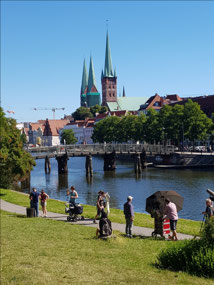
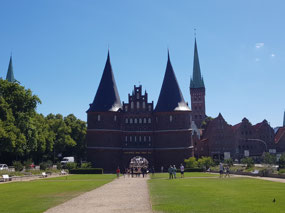
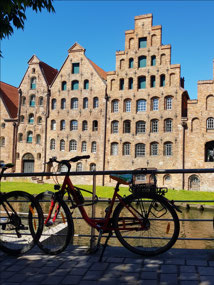
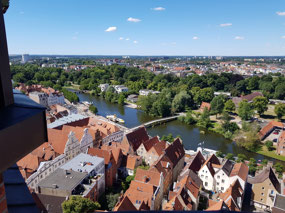
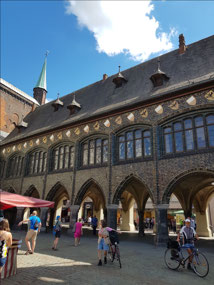
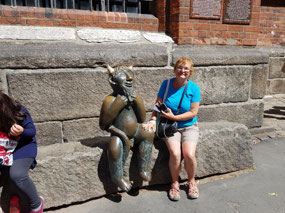
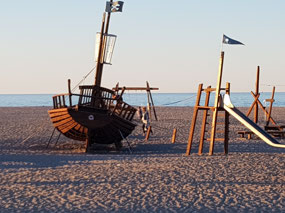
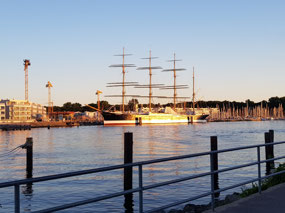







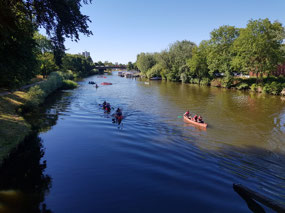
2025-05-22